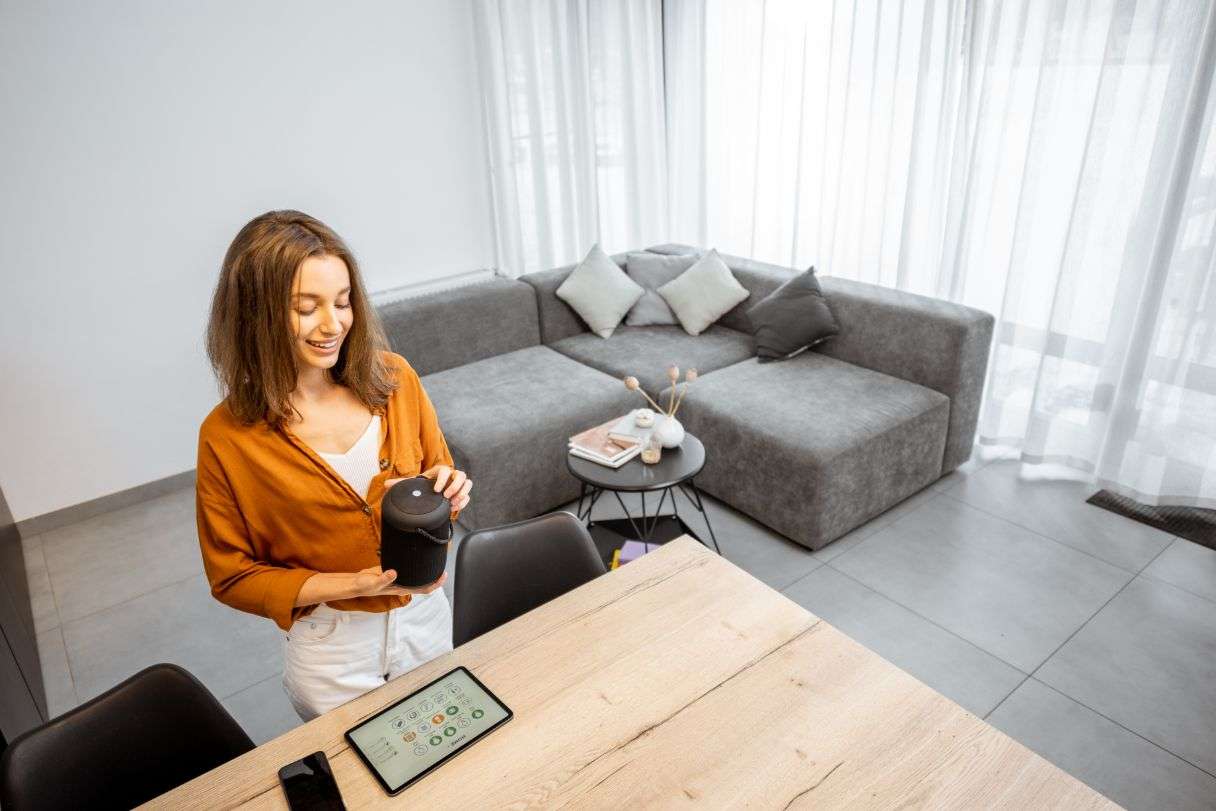Are you tired of the constant battle with your thermostat? Enter smart temperature control systems, revolutionizing the way we manage our home’s climate. What are the features of this smart temperature? We’ll explore seven remarkable features that make these systems a game-changer for comfort and efficiency. From customizable schedules and multi-zone control to learning algorithms, voice assistant integration, sensor technology, geofencing, and temperature history tracking, these innovations are reshaping the way we experience home comfort. So, Let’s take a closer look at seven key features of smart temperature control systems.
- Programmable Schedules
- Multi-Zone Control
- Learning Algorithms
- Voice Assistants
- Sensor Technology
- Geofencing
- Temperature History Tracking
Programmable Schedules

Imagine waking up to a cozy, warm home on a chilly winter morning, and returning to a refreshingly cool oasis on a scorching summer day, all without having to touch the thermostat. This magical convenience is made possible by the first feature we’ll delve into programmable schedules in smart temperature control systems. Programmable schedules are like your personal temperature concierge, ensuring that your home is always at the perfect temperature when you need it. Whether you’re an early bird, a night owl, or somewhere in between, these schedules adapt to your daily routine and preferences, creating a seamless blend of comfort and energy efficiency.
Setting up programmable schedules is as easy as a few taps on your smartphone or a few clicks on your computer.
You can define different temperature settings for various times of the day and days of the week. For instance, you can instruct your system to warm up the house in the morning as you wake up, then lower the temperature when you leave for work, and have it cozy and comfortable by the time you return. Imagine not having to endure a cold house when you step out of bed or the discomfort of a sweltering living room during a heatwave. Programmable schedules ensure that your home adapts to your schedule, not the other way around.
One of the most remarkable aspects of programmable schedules is their flexibility. You can fine-tune the settings to cater to your unique lifestyle. Are you working from home on a Wednesday afternoon or having a movie night on Friday? No problem! Adjust the schedule to suit your needs. For those who value a cool, comfortable bedroom for a good night’s sleep but prefer to conserve energy during the day, programmable schedules let you create distinct temperature zones within your home. The bedroom can be comfortably cool while the rest of the house remains energy-efficient.
Beyond comfort, programmable schedules are champions of energy efficiency.
They prevent your HVAC (Heating, Ventilation, and Air Conditioning) system from running unnecessarily when no one is home, slashing energy bills without sacrificing comfort. The result? A win-win situation for both your wallet and the environment. Think about the hours when you’re away at work or on vacation. With programmable schedules, your smart temperature control system automatically adjusts the temperature to an energy-saving mode. When you’re on your way back, you can use your smartphone to ensure that your home is back to your preferred temperature by the time you arrive. Smart temperature adapts to your daily rhythm, offering customized comfort and substantial energy savings. So, as you sip your morning coffee in that snug living room or enjoy a movie night in ideal conditions, you’ll realize that programmable schedules are the unsung heroes of home comfort and efficiency.
Multi-Zone Control

In the previous discussion, we uncovered the wonders of programmable schedules that adapt to your daily life, effortlessly blending comfort with energy savings. Now, let’s turn our attention to another game-changer: Multi-Zone Control. This feature takes home temperature management to a whole new level, allowing you to tailor the climate of different rooms or zones within your home with pinpoint precision. Before we delve into the mechanics of this feature, let’s understand why it’s so essential. Traditional thermostats treat your entire home as a single entity, meaning that if you want one room cooler and another warmer, you have to compromise somewhere in between. This can be frustrating, especially if you have varying temperature preferences throughout your home.
Multi-Zone Control resolves this issue by dividing your home into zones, each with its thermostat or temperature control sensor.
For instance, you can have one zone for the living room, another for the bedroom, and a separate one for the kitchen. This means that you can have different temperatures in each of these areas, providing customized comfort for every room. Picture this scenario: It’s a sweltering summer afternoon, and the living room gets plenty of sunlight, making it uncomfortably warm. With Multi-Zone Control, you can lower the temperature in the living room while keeping the bedroom comfortably cool for an afternoon nap. No more compromising on comfort; every room becomes its climate oasis.
Multi-zone control also allows for individualized schedules for each zone. If you have a room that’s rarely used, you can set it to an energy-saving mode when it’s unoccupied and ensure it’s comfortable when you decide to use it. This level of control optimizes energy efficiency without sacrificing comfort. Speaking of energy efficiency, Multi-Zone Control also helps you save on heating and cooling costs. When certain areas of your home don’t need to be as warm or cool as others, you can set those zones to a more energy-efficient temperature, reducing overall energy consumption.
Multi-zone control in smart temperature control systems empowers you with the ability to customize the climate in every room of your home. It eliminates the need for compromises, ensuring that each space caters to your comfort preferences. This feature also plays a pivotal role in energy conservation by allowing you to fine-tune temperatures and schedules based on actual usage. As you embrace the luxury of a perfectly tempered living room, a cozy bedroom, and an efficient kitchen, thanks to Multi-Zone Control, you’ll discover a new level of comfort and efficiency that truly transforms your living space.
Learning Algorithms

So far, we’ve uncovered the convenience of programmable schedules and the luxury of multi-zone control. Now, let’s embark on an exploration of the third feature that truly sets smart temperature control systems apart: Learning Algorithms. Dream of having a thermostat that not only responds to your commands but also learns your preferences over time, becoming an intuitive and energy-saving companion. That’s precisely what learning algorithms bring to the table. At its core, a learning algorithm is like a digital chameleon, constantly adapting to your changing needs and preferences. It takes note of when you adjust the temperature, how often you’re at home, and even factors like weather conditions. Over time, it uses this data to fine-tune your HVAC (Heating, Ventilation, and Air Conditioning) system’s behavior, making automatic adjustments that optimize comfort and energy efficiency.
Picture this scenario: You usually like the living room to be warm in the evenings when you’re winding down after a long day. With learning algorithms in place, your smart thermostat starts recognizing this pattern. It begins to automatically raise the temperature in the living room as the evening approaches, eliminating the need for you to manually adjust the thermostat each time. Learning algorithms aren’t just about comfort; they’re also champions of energy efficiency. They learn when you leave for work and return home, adjusting the temperature accordingly. No more heating or cooling an empty house! This not only enhances comfort but also significantly reduces energy consumption and lowers your utility bills.
The beauty of learning algorithms is that they work silently in the background, making your smart temperature control system a true set-and-forget solution.
You don’t need to be constantly tinkering with the thermostat because it learns your preferences and routines, creating a tailored and comfortable environment. Additionally, learning algorithms understand that everyone’s lifestyle is unique. They adapt to your specific needs, whether you’re an early riser, a night owl, or have irregular schedules. The result is a temperature control system that feels like it was designed just for you. Learning algorithms are the heart and soul of smart temperature control systems. They transform your thermostat from a simple device into a proactive and adaptable companion, providing seamless comfort while optimizing energy efficiency. As your home’s climate becomes more attuned to your needs, you’ll experience a new level of convenience and cost savings that truly make your house feel like a smart home.
Voice Assistants

Now, let’s embark on an exploration of the fourth feature that adds an extra layer of convenience and sophistication: Voice Assistants. Voice assistants have become an integral part of our daily lives, from setting reminders and answering questions to playing music and controlling smart devices. When it comes to smart temperature control, these virtual assistants elevate the experience to a whole new level. Keep this in mind: You’re lounging on your couch, engrossed in a book, and you suddenly feel a bit too warm. Instead of getting up or reaching for your smartphone, you simply utter a voice command like, “Hey, Alexa, lower the temperature by 2 degrees,” or “OK, Google, make it cooler in here.” Your smart temperature control system obediently adjusts the temperature to your liking, all without you lifting a finger.
Voice assistants like Amazon Alexa, Google Assistant, and Apple’s Siri seamlessly integrate with smart temperature control systems. This integration allows you to control your thermostat, change settings, and even inquire about the current temperature in various zones of your home simply by using your voice. The real magic lies in the hands-free convenience that voice assistants offer. Whether you’re busy in the kitchen, lounging on the couch, or even lying in bed, you can effortlessly control your home’s climate without any physical effort. It’s like having a personal climate genie at your beck and call. Voice assistants also serve as the bridge between your smart temperature control system and other connected devices in your home. You can create voice-activated routines that simultaneously adjust the thermostat, dim the lights, and lock the doors when you say goodnight.
This level of automation not only enhances convenience but also enhances security and energy efficiency.
What’s particularly remarkable about voice assistants is their user-friendliness. You don’t need to be tech-savvy to use them effectively. They understand natural language, making interactions intuitive and accessible for everyone in the household. Voice assistants add a layer of sophistication and unparalleled convenience to smart temperature control systems. They transform your home into a place where your comfort and preferences are just a voice command away. Whether you’re looking to make a room warmer, cooler, or just right, voice assistants offer a seamless and effortless way to control your home’s climate.
Sensor Technology

Imagine having a thermostat that could detect not only the temperature in your home but also occupancy, humidity levels, and even the presence of sunlight. This is precisely what sensor technology brings to the table. These sensors are the eyes and ears of your smart temperature control system, providing critical data for precise and efficient climate management.
Temperature Sensors
At the core of sensor technology are temperature sensors. These sensors constantly measure the temperature in various areas of your home, ensuring that each zone stays at your desired comfort level. Whether it’s a chilly winter day or a scorching summer afternoon, these sensors work tirelessly to maintain the perfect temperature. What truly sets temperature sensors in smart systems apart is their ability to integrate data from multiple sensors to make informed decisions. If one room is too warm and another is too cold, the system can balance these conditions by adjusting heating or cooling accordingly, ensuring overall comfort while optimizing energy efficiency.
Occupancy Sensors
Occupancy sensors are another crucial component of sensor technology. They detect whether a room is occupied or empty, allowing your smart temperature control system to make intelligent decisions. When an occupancy sensor detects activity in a room, it signals the smart thermostat to adjust the temperature to the desired comfort level for the occupant(s). This precision control ensures that the climate is tailored to your needs when you’re present in a room.
Humidity Sensors
Humidity sensors monitor the moisture levels in your home. Proper humidity control is essential for comfort and health. These sensors help prevent issues like overly dry air in the winter or excessive humidity in the summer, creating a more comfortable living environment. Humidity sensors typically use a variety of technologies to measure moisture levels in the air. One common method involves a thin film that absorbs or desorbs moisture, leading to changes in electrical resistance. These changes are then converted into humidity readings. Another method uses capacitance, where the sensor measures how much water vapor is present by examining how it affects the electrical charge on a capacitor.
Sunlight Sensors
Sunlight sensors are particularly beneficial for rooms with large windows. They can detect the intensity of sunlight and adjust the temperature accordingly. On a sunny day, the system might reduce cooling to prevent overheating, while on a cloudy day, it can maintain a consistent temperature. Sensor technology is the unsung hero of smart temperature control systems. These sensors work together seamlessly to provide precise and efficient climate management in your home. Whether it’s maintaining the perfect temperature, adjusting for occupancy, managing humidity, or responding to sunlight, sensors ensure that your home’s climate is always comfortable, efficient, and tailored to your needs.
Geofencing

Let’s venture into the realm of Geofencing, a feature that adds a touch of magic to your smart home’s climate control.
Understanding Geofencing
Imagine this scenario: You’re on your way home from work, and you want your house to be the perfect temperature when you arrive. Geofencing makes it happen. It’s a virtual fence or boundary that your smart temperature control system uses to detect when you’re approaching or leaving your home. At its core, Geofencing relies on the GPS technology in your smartphone. When you cross the predetermined boundary (often set to a certain radius around your home), your smartphone communicates with your smart thermostat or temperature control system, signaling that you’re on your way or leaving. This prompts your system to make temperature adjustments accordingly.
Comfort and Efficiency
Geofencing allows you to predefine your preferred homecoming temperature. As you approach your home, your system takes note and starts warming up or cooling down your living space to ensure it’s just the way you like it when you step through the door. It’s like having a personal climate butler who welcomes you with open arms (or a blast of cool air, depending on your preference). But Geofencing isn’t just about comfort; it’s also about energy efficiency. When you leave your home’s Geofence, your smart system knows you’re no longer there and can automatically adjust the temperature to an energy-saving mode. You won’t waste a dime or a kilowatt-hour heating or cooling an empty house.
Safety and Convenience
Many smart temperature control systems allow you to set up Geofencing for different zones within your home. For instance, you can have one Geofence for the main living area and another for the bedrooms. This way, your system can prepare specific zones based on the occupants’ arrival. Geofencing can also be configured for each family member with a smartphone. So, if you and your partner are on different schedules, your home’s climate adjusts to whoever is on their way back. Geofencing can provide an added layer of security. If you’re away on vacation and someone unauthorized enters your Geofenced area, you can receive an alert, allowing you to take appropriate action. Geofencing is like the guardian angel of your home’s climate control. It ensures that your living space is always at the perfect temperature when you arrive and conserves energy when you’re not there. With customizable zones and the ability to cater to your family’s unique schedules, it adds a layer of personalized comfort and convenience to your smart home.
Temperature History Tracking
![]()
Lastly, Temperature History Tracking, a feature that provides insight into your home’s climate evolution like never before.
How History Tracking Works
Visualize having access to a detailed record of your home’s temperature patterns over time. Temperature History Tracking offers precisely that. It’s like a digital diary of your home’s comfort journey, and it can be a game-changer in understanding and optimizing your climate control. This feature continuously records temperature data, creating a historical log of your home’s climate. It tracks when temperature adjustments were made, the duration of heating or cooling cycles, and how different zones within your home responded to changes. Temperature History Tracking allows you to view your home’s climate evolution in graphical form, often accessible through a smartphone app or web interface. You can analyze patterns, identify trends, and gain insights into how your temperature settings impact energy consumption and comfort.
Energy Usage Awareness
One of the most significant benefits of Temperature History Tracking is its role in raising awareness about energy usage. By examining the historical data, you can see precisely when your HVAC system was active and when it was in energy-saving mode. This information empowers you to make informed decisions about how to reduce energy consumption and save on utility bills.
Optimizing Temperature Schedules
Temperature History Tracking can also help you fine-tune your programmable schedules. By reviewing past temperature settings and occupancy patterns, you can make adjustments to your schedules for more efficient climate control. Optimizing Temperature Schedules should also consider seasonal changes. As the weather shifts from winter to summer, or vice versa, you can adjust your schedules to reflect these transitions. For instance, you may need more cooling in the summer and less heating in the winter.
Diagnosing Issues
If you ever encounter temperature inconsistencies or issues with your HVAC system, Temperature History Tracking becomes a diagnostic tool. You can review the historical data to identify when the problem occurred and what might have triggered it, helping you or your technician pinpoint and resolve issues faster.
Customized Comfort
Perhaps one of the most valuable aspects of this feature is its role in customizing your comfort. As you gain a deeper understanding of temperature patterns in your home, you can adjust settings to match your preferences and routines more closely. This level of customization ensures that your home is always comfortable when you need it to be. Temperature History Tracking is the digital historian of your home’s climate. It offers insights, awareness, and the power to optimize your temperature control for energy efficiency and comfort. As you review the historical data, you’ll gain a deeper understanding of your home’s unique climate patterns and find opportunities to make your living space smarter, more comfortable, and more efficient.
In the ever-evolving landscape of modern living, the journey to a smarter, more comfortable home has never been more exciting. We’ve embarked on a voyage through the seven remarkable features of smart temperature control, uncovering the magic that transforms houses into intelligent havens. It’s time to transform your home into a haven of comfort and efficiency. Discover the future of climate control and take the leap into a smarter, more comfortable home today. Buy our smart temperature control system and experience the difference by yourself!
